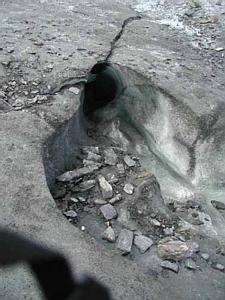12 July, 2000
July 12, 2000
Matanuska Glacier, Alaska
This morning we once again retrieved samples from our two vent stations.
After graphing the conductivities we feel as though we may have some
good leads to investigate now. It still seems too soon to believe we
have made a moulin/vent connection but todayís results provided us with
enough information that we are modifying our procedure. Tonight we will
increase the salt input and collect samples every thirty minutes instead
of fifteen. We think we might be seeing something coming out at Little
River Vent. We will be able to monitor a twelve hour period now in hopes
that we might see a complete rise and fall in the conductivity. One
concern for tonight is that a good rain fell at the same time we dumped
the salt. Weíve already found that the rainwater has twice the
conductivity of the vent discharges. Our hope is that it will affect
both vents equally.
I wanted to take a little time to talk about the Matanuska Glacier. It
is located just off the Glenn Highway at Mile 102 about 80 miles
northeast of Anchorage. It drains about 250 square miles of the central
Chugach Mountains between Mount Marcus Baker and Mount Witherspoon. This
glacier is considered to be a stable ice flow that is about four miles
wide at its terminus and roughly twenty-seven miles long. It averages
two miles in width. It is a valley glacier as it exists on a valley
floor. Most other glaciers in Alaska hang off mountain slopes and are
alpine glaciers.
Work by the U.S. Geological survey in the mid-1950s showed that it was
moving very little. They also found that moraines less than 200 years
old were just a quarter mile in front of the terminus. A moraine is rock
debris piled up along the lateral (side) or terminal (end) parts of a
glacier or laid down beneath it, as well as to the accumulations of
rock debris on its surface. The debris can consist of large boulders,
gravel, sand and silt. Advances about four to eight thousand years ago
left moraines one to five miles beyond todayís terminus. About 18,000
years ago it covered the town of Palmer more than fifty miles to the
west. During the summer of 1979, part of the glacier advanced over 100
feet in two months. The terminus of the glacier is generally stable
today.
As I visit the different places around the glacier from day to day what
strikes me is how much it changes. A visitor who stops at the parking
area to snap a picture is missing an awesome experience if they donít go
out onto the glacier. There is so much to investigate on the ice. And
the day visitor who ventures out onto the ice still misses so much. I am
fortunate in that I see the glacier as a dynamic, ever changing
spectacle. I cannot see the advance or retreat of the ice. However, I
do see all sorts of features appear and disappear. Iíve quickly learned
to take pictures at every chance. The opportunity may be gone tomorrow.
It seems that every time I hike to the moulin there is something
different along the way than the day before. The levels on two sides of
a crack in the ice change. A large moulin appears seemingly overnight.
Small trickles carve canyons much faster than you can imagine. Sometimes
it seems that you could explain every landform on earth by observing
processes that shape the glacier. I grow more and more fascinated with
it every day!
Marvin Giesting

This moulin seemed to appear over night and is very close to Trail Vent. The tunnel is perhaps 2 feet in diameter and was carved into a crack in the ice.

Panorama of the glacier made from several pictures. There's a large area of the terminus that could not be seen to the left of the picture. Most of the terminus is covered with rock debris. The small stream just left of center is the discharge from Trail Vent.
Contact the TEA in the field at
.
If you cannot connect through your browser, copy the
TEA's e-mail address in the "To:" line of
your favorite e-mail package.
|
